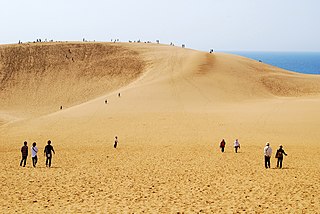This article needs additional citations for verification .(November 2014) (Learn how and when to remove this template message) |
| Tottori 鳥取市 | |||
|---|---|---|---|
| Core city | |||
From top left:Tottori Castle, Shikano(old castle town), Tottori Sand Dunes, Jinpūkaku, View of Tottori from Tottori Castle | |||
| |||
 Location of Tottori in Tottori Prefecture | |||
| Coordinates: 35°30′N134°14′E / 35.500°N 134.233°E Coordinates: 35°30′N134°14′E / 35.500°N 134.233°E | |||
| Country | Japan | ||
| Region | Chūgoku (Sanin) | ||
| Prefecture | Tottori Prefecture | ||
| Government | |||
| • Mayor | Yoshihiko Fukazawa [1] | ||
| Area | |||
| • Total | 765.31 km2 (295.49 sq mi) | ||
| Population (June 1, 2016) | |||
| • Total | 192,912 | ||
| • Density | 250/km2 (650/sq mi) | ||
| Symbols | |||
| • Tree | Camellia sasanqua | ||
| • Flower | Allium chinense | ||
| • Bird | Blue-and-white flycatcher | ||
| Time zone | Japan Standard Time (UTC+9) | ||
| City hall address | 116 Shutoku-cho, Tottori-shi, Tottori-ken 680-8571 | ||
| Website | city | ||
Tottori(鳥取市Tottori-shi) is the capital city of Tottori Prefecture in the Chūgoku region of Japan.

A city is a local administrative unit in Japan. Cities are ranked on the same level as towns and villages, with the difference that they are not a component of districts. Like other contemporary administrative units, they are defined by the Local Autonomy Law of 1947.

Tottori Prefecture is a prefecture of Japan located in the Chūgoku region. The capital is the city of Tottori. It is the least populous prefecture in Japan.

The Chūgoku region, also known as the San'in-San'yō region, is the westernmost region of Honshū, the largest island of Japan. It consists of the prefectures of Hiroshima, Okayama, Shimane, Tottori, and Yamaguchi. In 2010, it had a population of 7,563,428.
Contents
- Outline
- History
- Education
- Transportation
- Notable places
- Climate
- Twin towns
- References
- External links
As of June 1, 2016, the city has an estimated population of 192,912 and a population density of 250 persons per km2. The total area is 765.31 km2.

In biology, a population is the number of all the organisms of the same group or species, which live in a particular geographical area, and have the capability of interbreeding. The area of a sexual population is the area where inter-breeding is potentially possible between any pair within the area, and where the probability of interbreeding is greater than the probability of cross-breeding with individuals from other areas.

Population density is a measurement of population per unit area or unit volume; it is a quantity of type number density. It is frequently applied to living organisms, and most of the time to humans. It is a key geographical term. In simple terms population density refers to the number of people living in an area per kilometer square.
Within Japan the city is best known for its sand dunes which are a popular tourist attraction, drawing visitors from outside the prefecture. The sand dunes are also important as a centre for research into arid agriculture, hosting Tottori University's Arid Land Research Center. Most of Tottori is located in the western part of the San'in Kaigan Geopark.[ citation needed ]

The Tottori Sand Dunes are sand dunes located near the city of Tottori in Tottori Prefecture, Japan. They form the only large dune system in Japan.

National University Corporation Tottori University, abbreviated to Toridai (鳥大), is a national university in Japan. The main campus is located in Koyamachō-Minami, Tottori City, Tottori Prefecture. Another campus, the Faculty of Medicine, is located on the Yonago Campus in Yonago, Tottori.

The San'in Kaigan Geopark (山陰海岸ジオパーク) is a geopark in Japan. The area was declared a Japanese Geopark in 2008, and a UNESCO Global Geopark in 2010. The underlying themes of the geopark are "geological features, the natural environment, people's lives, and the formation of the Sea of Japan". This geologically diverse area contains records of the process from when Japan was part of the Asian continent to its present-day formation of the Sea of Japan. People's lives are also diverse in this area because of its geodiversity.
















